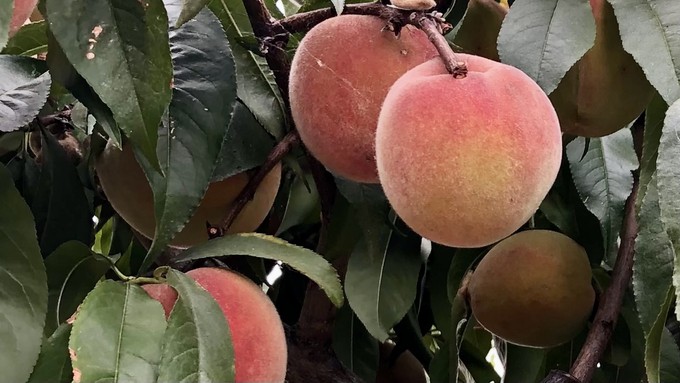
El Dorado County master gardeners offer free workshop at Sherwood Demonstration Garden

Peach trees and other orchard trees can benefit from summer pruning. Get tips on how to do it from the El Dorado County master gardeners this Saturday. Kathy Morrison
Got fruit? If your backyard orchard produces a sparse harvest (or so much that limbs break under the load), consider the benefits of summer pruning.
Learn how at a free workshop at 9 a.m. Saturday, July 27, at Sherwood Demonstration Garden in Placerville.
Hosted by the El Dorado County master gardeners, “Summer Fruit Tree Pruning” will cover the basics plus a lot more. During this three-hour class, master gardener Phyllis Lee will demonstrate techniques as well as what to look for, using Sherwood’s own orchard as an example.
“Summer fruit tree pruning is a science and an art,” say the master gardeners. “Come out to the beautiful and educational Sherwood Demonstration Garden to learn the benefits of summer fruit tree pruning: What to prune in the summer versus winter, the reasoning, creating fruitful trees, and more.”
Advance registration is encouraged but not required. Find it here: https://surveys.ucanr.edu/survey.cfm?surveynumber=42879
“Also, we have plenty of space, but a shortage of chairs; if you can, please bring your own folding chair,” say the hosts.
This workshop is a great way to learn more about keeping fruit trees healthy and productive. Say the master gardeners, “In this informative class for beginners as well as intermediate learners, different pruning techniques will be demonstrated along with general fruit tree care of pome (apple, pear, etc.), stone (peach, plum, cherry, etc.), persimmon and citrus trees.”
Although the class is free, parking is $2. Sherwood Demonstration Garden is located behind Folsom Lake College’s El Dorado Center at 6699 Campus Drive, Placerville.
Saturday morning is also Open Garden at Sherwood; visitors are welcome to ask master gardeners questions on a wide range of topics and garden activities.
Details and directions: https://mgeldorado.ucanr.edu/.
Comments
0 comments have been posted.Sacramento Digs Gardening to your inbox.
Food in My Back Yard Series
April 29: What's (already) wrong with my tomato plants?
April 22: Should you stock up on fertilizer? (Yes!)
April 15: Grow culinary herbs in containers
April 8: When to plant summer vegetables
April 1: Don't be fooled by these garden myths
March 25: Fertilizer tips: How to 'feed' your vegetables for healthy growth
March 18: Time to give vegetable seedlings some more space
March 11: Ways to win the fight against weeds
March 4: Potatoes from the garden
Feb. 25: Plant a fruit tree now -- for later
Feb. 18: How to squeeze more food into less space
Feb. 11: When to plant? Consider staggering your transplants
Feb. 4: Starting in seed starting
Sites We Like
Garden Checklist for week of May 4
Enjoy this spring weather – and get gardening!
* Plant, plant, plant! It’s prime planting season in the Sacramento area. Time to set out those tomato transplants along with peppers and eggplants. Pinch off any flowers on new transplants to make them concentrate on establishing roots instead of setting premature fruit.
* Direct-seed melons, cucumbers, summer squash, corn, radishes, pumpkins and annual herbs such as basil.
* Harvest cabbage, lettuce, peas and green onions.
* In the flower garden, direct-seed sunflowers, cosmos, salvia, zinnias, marigolds, celosia and asters. (You also can transplant seedlings for many of the same flowers.)
* Plant dahlia tubers. Other perennials to set out include verbena, coreopsis, coneflower and astilbe.
* Transplant petunias, marigolds and perennial flowers such as astilbe, columbine, coneflowers, coreopsis, dahlias, rudbeckia and verbena.
* Keep an eye out for slugs, snails, earwigs and aphids that want to dine on tender new growth.
* Feed summer bloomers with a balanced fertilizer.
* For continued bloom, cut off spent flowers on roses as well as other flowering plants.
* Add mulch to the garden to maintain moisture. Mulch also cuts down on weeds. But don’t let it mound around the stems or trunks of trees or shrubs. Leave about a 6-inch to 1-foot circle to avoid crown rot or other problems.